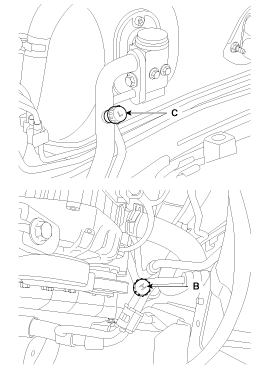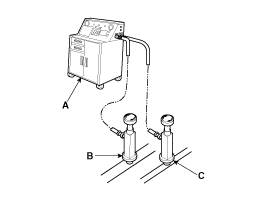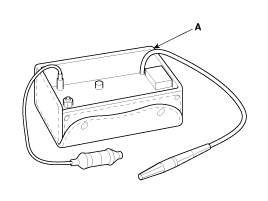 Kia Rio: Refrigerant System Service Basics
Kia Rio: Refrigerant System Service Basics
Refrigerant Recovery
Use only service equipment that is U.L-listed and is certified to meet
the requirements of SAE J2210 to remove HFC-134a (R-134a) from the air conditioning
system.
|
If accidental system discharge occurs, ventilate work area before resume
of service
.Additional health and safety information may be obtained from the refrigerant
and lubricant manufacturers.
| 1. |
Connect an R-134a refrigerant
Recovery/Recycling/Charging System (A) to the high-pressure service
port (B) and the low-pressure service port (C) as shown, following the
equipment manufacturer's instructions.
|
| 2. |
Measure the amount of refrigerant oil removed from the A/C system
after the recovery process is completed. Be sure to install the same
amount of new refrigerant oil back into the A/C system before charging.
|
System Evacuation
Use only service equipment that is U.L-listed and is certified to meet
the requirements of SAE J2210 to remove HFC-134a (R-134a) from the air conditioning
system.
|
If accidental system discharge occurs, ventilate work area before resume
of service.
Additional health and safety information may be obtained from the refrigerant
and lubricant manufacturers.
| 1. |
When an A/C System has been opened to the atmosphere, such as
during installation or repair, it must be evacuated using an R-134a
refrigerant Recovery/Recycling/Charging System. (If the system has been
open for several days, the receiver/dryer should be replaced, and the
system should be evacuated for several hours.)
|
| 2. |
Connect an R-134a refrigerant
Recovery/Recycling/Charging System (A) to the high-pressure service
port (B) and the low-pressure service port (C) as shown, following the
equipment manufacturer's instructions.
|
| 3. |
If the low-pressure does not reach more than 93.3 kPa (700 mmHg,
27.6 in.Hg) in 10 minutes, there is probably a leak in the system. Partially
charge the system, and check for leaks (see ŌĆ£Refrigerant Leak TestŌĆØ).
|
| 4. |
Remove the low pressure valve from the low-pressure service port.
|
System Charging
Use only service equipment that is U.L-listed and is certified to meet
the requirements of SAE J2210 to remove HFC-134a (R-134a) from the air conditioning
system.
|
If accidental system discharge occurs, ventilate work area before resume
of service.
Additional health and safety information may be obtained from the refrigerant
and lubricant manufacturers.
| 1. |
Connect an R-134a refrigerant
Recovery/Recycling/Charging System (A) to the high-pressure service
port (B) as shown, following the equipment manufacturer's instructions.
|
| 2. |
Add the same amount of new refrigerant oil to system that was
removed during recovery. Use only specified refrigerant oil. Charge
the system with 470 ┬▒ 25g (16.5 ┬▒ 0.88 oz.) of R-134a refrigerant. Do
not overcharge the system the compressor will be damaged.
|
Refrigerant Leak Test
Always conduct a leak test with an electronic leak detector whenever leakage
or refrigerant is suspected and when conducting service operations which are
accompanied by disassembly or loosening or connection fittings.
In order to use the leak detector properly, read the manual supplied
by the manufacturer.
|
If a gas leak is detected, proceed as follows :
| 1. |
Check the torque on the connection fittings and, if too loose,
tighten to the proper torque. Check for gas leakage with a leak detector
(A).
|
| 2. |
If leakage continues even after the fitting has been tightened,
discharge the refrigerant from the system, disconnect the fittings,
and check their seating faces for damage. Always replace, even if the
damage is slight.
|
| 3. |
Check the compressor oil and add oil if required.
|
| 4. |
Charge the system and recheck for gas leaks. If no leaks are found,
evacuate and charge the system again.
|
 Air Outlet and Air Flow
Air Outlet and Air Flow
The mode selection switch controls the direction of the air
flow through the ventilation
System
Air Flow
Symbol
Outlet
Description
...
 Component Location Index
Component Location Index
Engine Room
1. Receiver Drier
2. Condenser
3. Ambient Temperature Sensor
4. Compressor
5. Discharge Hose
6. Suction & Liquid Tube Assembly
7. Service ...
See also:
Components
1. Battery (Non-ISG Type)
2. Battery (ISG Type)
3. Battery tray
4. Battery insulation pad
5. Battery mounting bracket
...
Warnings and indicators
All warning lights are checked by turning the ignition switch ON (do not start
the engine). Any light that does not illuminate should be checked by an authorized
Kia dealer.
After starting the en ...
Smart key unit Circuit diagram
No.
Connector A(26 pins)
No.
Connector B(16 pins)
No.
Connector C(22 pins)
1
VBAT_LOAD
1
C_CAN_L
1
O_S ...
Copyright ® www.kirmanual.com 2014-2025





